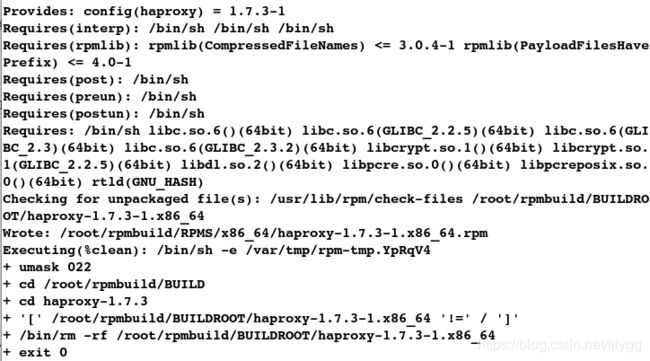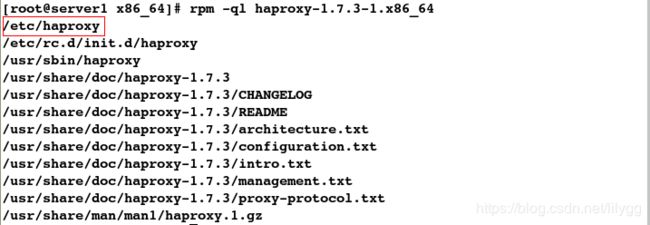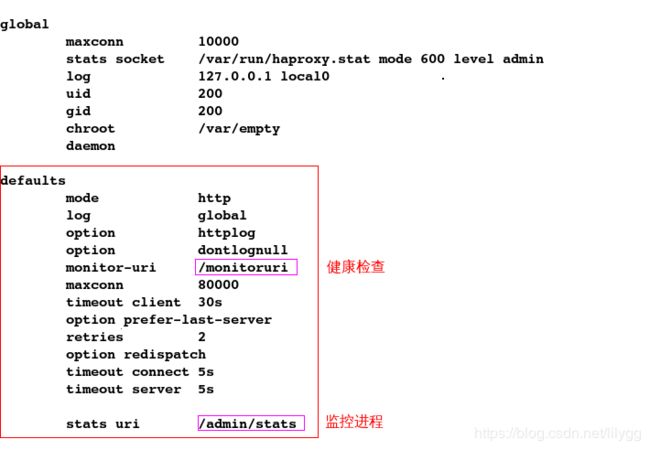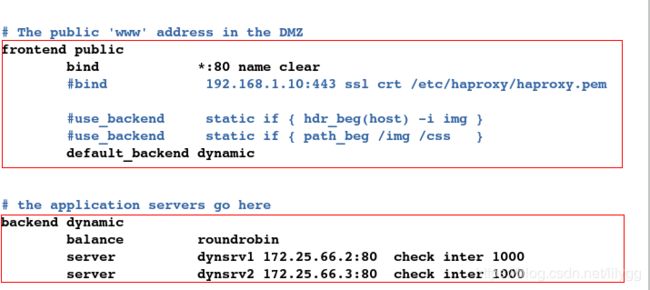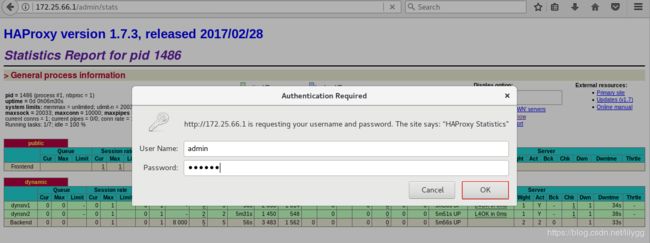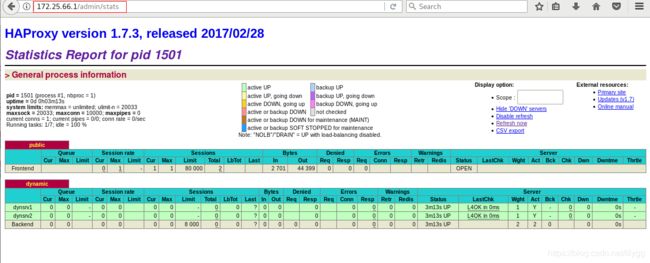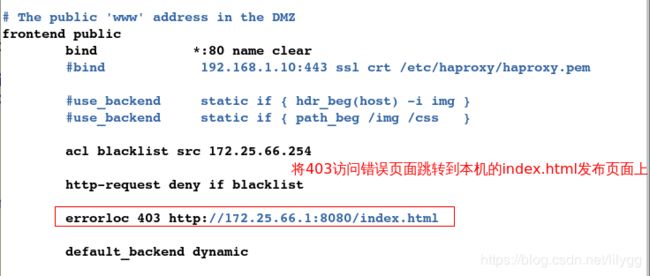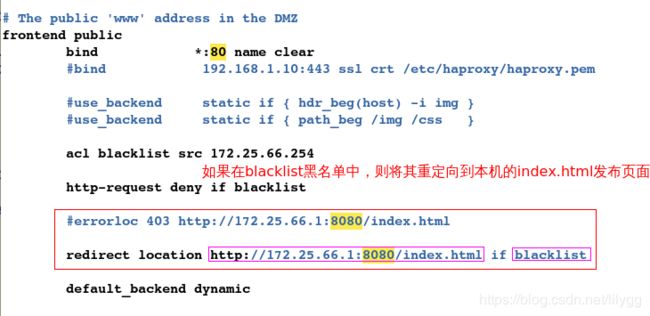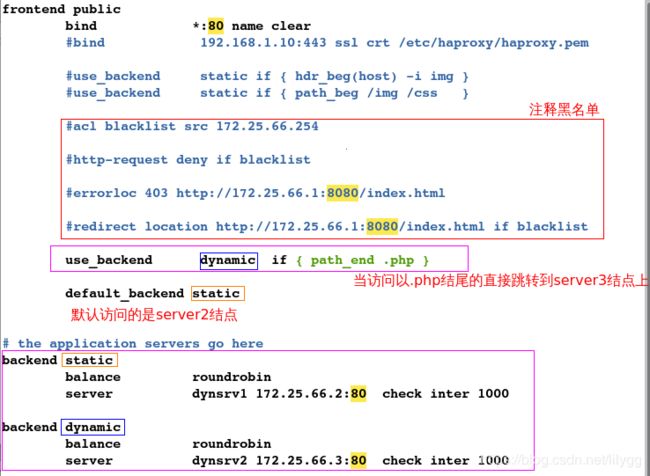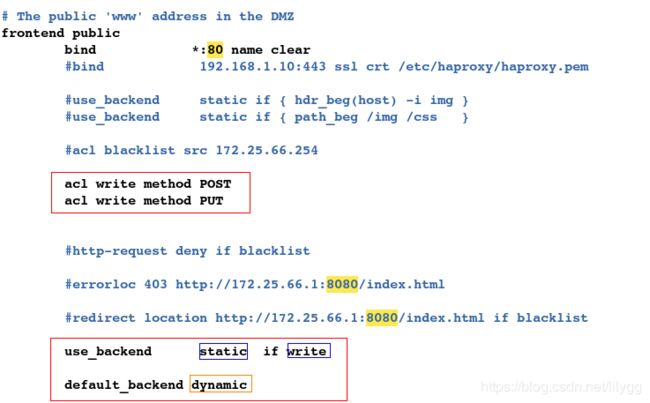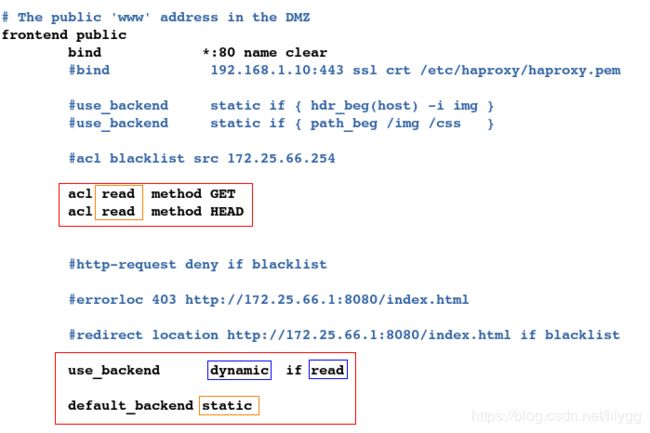Haproxy的安装与配置
haproxy概述:
HAProxy是一个使用C语言编写的自由及开放源代码软件,它提供高可用性、负载均衡,以及基于TCP和HTTP的应用程序代理。
HAProxy特别适用于那些负载特大的web站点,这些站点通常又需要会话保持或七层处理。HAProxy运行在当前的硬件上,
完全可以支持数以万计的并发连接。并且它的运行模式使得它可以很简单安全的整合进您当前的架构中, 同时可以保护你的web服务器不被暴露到网络上。
HAProxy实现了一种事件驱动, 单一进程模型,此模型支持非常大的并发连接数。多进程或多线程模型受内存限制 、
系统调度器限制以及无处不在的锁限制,很少能处理数千并发连接。事件驱动模型因为在有更好的资源和时间管理的用户空间(User-Space) 实现所有这些任务,所以没有这些问题。
此模型的弊端是,在多核系统上,这些程序通常扩展性较差。这就是为什么他们必须进行优化以使每个CPU时间片(Cycle)做更多的工作
实验环境:
server1:172.25.66.1 haproxy服务器端
server2:172.25.66.2 apache后端服务器
server3:172.25.66.3 apache后端服务器
1.haproxy的安装
安装包:
haproxy-1.7.3.tar.gz
点击此处即可下载haproxy安装包
1.下载haproxy安装包并解压
#1.下载
[root@server1 ~]# ls
haproxy-1.7.3.tar.gz
#2.解压
[root@server1 ~]# tar zxf haproxy-1.7.3.tar.gz
[root@server1 ~]# ls
haproxy-1.7.3 haproxy-1.7.3.tar.gz
[root@server1 ~]# cd haproxy-1.7.3
[root@server1 haproxy-1.7.3]# ls
CHANGELOG doc include Makefile scripts tests
contrib ebtree LICENSE README src VERDATE
CONTRIBUTING examples MAINTAINERS ROADMAP SUBVERS VERSION
2. 制作rpm包
#前提:存在以.spec结尾的文件
[root@server1 haproxy-1.7.3]# find -name *.spec
./examples/haproxy.spec
#1.安装rpm-build工具(制作rpm包的工具)
[root@server1 ~]# yum install -y rpm-build
#制作包编译:报错
[root@server1 ~]# rpmbuild -tb haproxy-1.7.3.tar.gz
error: Failed build dependencies:
pcre-devel is needed by haproxy-1.7.3-1.x86_64
#2.解决依赖性
[root@server1 ~]# yum install -y pcre-devel
[root@server1 ~]# rpmbuild -tb haproxy-1.7.3.tar.gz
[root@server1 ~]# yum install -y gcc
#3.制作包编译;没有error报错即可
[root@server1 ~]# rpmbuild -tb haproxy-1.7.3.tar.gz
#1.发现生成了rpmbuild目录
[root@server1 ~]# ls
haproxy-1.7.3 haproxy-1.7.3.tar.gz rpmbuild
[root@server1 ~]# cd rpmbuild/RPMS/x86_64
[root@server1 x86_64]# ls
haproxy-1.7.3-1.x86_64.rpm
#2.安装; i:install v:view h:hash(哈希)
[root@server1 x86_64]# rpm -ivh haproxy-1.7.3-1.x86_64.rpm
#3.查看配置文件
[root@server1 x86_64]# rpm -ql haproxy-1.7.3-1.x86_64
2.负载均衡
1.拷贝配置文件
root@server1 ~]# cd /root/haproxy-1.7.3/examples/
#拷贝文件并重命名
[root@server1 examples]# cp content-sw-sample.cfg /etc/haproxy/haproxy.cfg
[root@server1 examples]# cd /etc/haproxy
[root@server1 haproxy]# ls
haproxy.cfg
#查看参数
[root@server1 haproxy]# vim haproxy.cfg
[root@server1 haproxy]# id haproxy
id: haproxy: No such user
#1.建立组
[root@server1 haproxy]# groupadd -g 200 harproxy
#2.建立用户
[root@server1 haproxy]# useradd -u 200 -g 200 -s /sbin/nologin -M haproxy
[root@server1 haproxy]# id haproxy
uid=200(haproxy) gid=200(harproxy) groups=200(harproxy)
#发现可以切换到haproxy用户,但只是提供了一个shell而已
[root@server1 haproxy]# su - haproxy
su: warning: cannot change directory to /home/haproxy: No such file or directory
-bash-4.1$ exit
logout
3.更改配置文件
[root@server1 haproxy]# pwd
/etc/haproxy
#更改配置文件
[root@server1 haproxy]# vim haproxy.cfg
#######################
defaults
mode http #默认的模式mode
log global #应用全局的日志配置
option httplog #启用日志记录HTTP请求,默认haproxy日志记录是不记录HTTP请求日志
option dontlognull #启用该项,日志中将不会记录空连接
monitor-uri /monitoruri #健康检查
maxconn 80000 #每个进程可用的最大连接数
timeout client 30s #客户端超时
stats uri /admin/stats #监控进程
option prefer-last-server
retries 2 #定义连接后端服务器的失败重连次数,连接失败次数超过此值后将会将对应后端服务器标记为不可用
option redispatch #当使用了cookie时,haproxy将会将其请求的后端服务器的serverID插入到cookie中,以保证会话的SESSION持久性;而此时,如果后端的服务器宕掉
timeout connect 5s #连接超时
timeout server 5s #服务器端超时
frontend public
bind *:80 name clear
#bind 192.168.1.10:443 ssl crt /etc/haproxy/haproxy.pem
#use_backend static if { hdr_beg(host) -i img }
#use_backend static if { path_beg /img /css }
default_backend dynamic
backend dynamic
balance roundrobin #负载均衡算法
server dynsrv1 172.25.66.2:80 check inter 1000 #后端1
server dynsrv2 172.25.66.3:80 check inter 1000 #后端2
[root@server1 haproxy]# /etc/init.d/haproxy start
Starting haproxy: [ OK ]
[root@server1 haproxy]# netstat -tnlp
5.配置后端服务器
在server2上:
#1.安装apache
[root@server2 ~]# yum install -y httpd
[root@server2 ~]# cd /var/www/html/
[root@server2 html]# ls
#2.编写默认发布文件
[root@server2 html]# vim index.html
[root@server2 html]# cat index.html
server2
#3.开启apache
[root@server2 html]# /etc/init.d/httpd start
Starting httpd: httpd: Could not reliably determine the server's fully qualified domain name, using 172.25.66.2 for ServerName
[ OK ]
在server3上:
#1.安装apache
[root@server3 ~]# yum install -y httpd
[root@server3 ~]# cd /var/www/html/
[root@server3 html]# ls
#2.编写默认发布文件
[root@server3 html]# vim index.html
[root@server3 html]# cat index.html
server3
#3.开启apache
[root@server3 html]# /etc/init.d/httpd start
Starting httpd: httpd: Could not reliably determine the server's fully qualified domain name, using 172.25.66.3 for ServerName
[ OK ]
测试:
在网页上输入:172.25.66.1,发现server2与server3交替出现,即实现了负载均衡


输入:172.25.66.1/monitoruri 查看健康检查

输入:172.25.66.1/admin/stats 监控结点信息
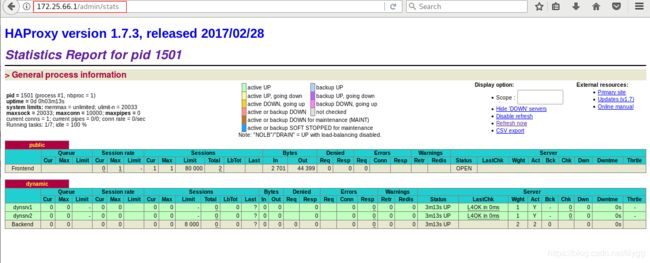
3.用户认证
[root@server1 haproxy]# pwd
/etc/haproxy
#1.更改配置文件
[root@server1 haproxy]# vim haproxy.cfg
#######################
stats auth admin:westos #设定认证用户和密码
stats refresh 5s #每5秒刷新一次
#2.重新启动
[root@server1 haproxy]# /etc/init.d/haproxy restart
Shutting down haproxy: [ OK ]
Starting haproxy: [ OK ]
网页测试:
4.日志管理
#1.更改日志配置文件
[root@server1 haproxy]# vim /etc/rsyslog.conf
#######################
$ModLoad imudp #开启日志端口
$UDPServerRun 514
*.info;mail.none;authpriv.none;cron.none;local0.none /var/log/messages
local0.* /var/log/haproxy.log #指定日志存放路径
#2.重启rsyslog服务
[root@server1 haproxy]# /etc/init.d/rsyslog restart
Shutting down system logger: [ OK ]
Starting system logger: [ OK ]
测试:
[root@server1 haproxy]# cd /var/log
[root@server1 log]# cat haproxy.log
5.调度算法
#1.更改调度算法
[root@server1 haproxy]# pwd
/etc/haproxy
[root@server1 haproxy]# vim haproxy.cfg
######################
balance source #将请求的源地址进行hash运算,并由后端服务器的权重总数相除后派发至某匹配的服务器.这可以使得同一个客户端IP的请求始终被派发至某特定的服务器
#2.重新加载
[root@server1 haproxy]# /etc/init.d/haproxy reload
测试:
#发现访问的一直都是server2,因为是同一个客户端IP的请求
[root@foundation66 ~]# curl 172.25.66.1
server2
[root@foundation66 ~]# curl 172.25.66.1
server2
[root@foundation66 ~]# curl 172.25.66.1
server2
还原:
[root@server1 haproxy]# vim haproxy.cfg
#######################
balance roundrobin #轮询算法
#重新加载
[root@server1 haproxy]# /etc/init.d/haproxy reload
6.访问控制
#1.设定黑名单
[root@server1 haproxy]# pwd
/etc/haproxy
[root@server1 haproxy]# vim haproxy.cfg
#######################
acl blacklist src 172.25.66.254 #acl访问控制;设定黑名单:拒绝在blacklist列表中的主机访问
http-request deny if blacklist
#2.重新加载
[root@server1 haproxy]# /etc/init.d/haproxy reload
测试:
#1.server2主机访问正常
[root@server2 ~]# curl 172.25.66.1
server2
[root@server2 ~]# curl 172.25.66.1
server3
#2.server3主机访问正常
[root@server3 ~]# curl 172.25.66.1
server2
[root@server3 ~]# curl 172.25.66.1
server3
#3.物理机访问失败,因为它在黑名单中
[root@foundation66 ~]# curl 172.25.66.1

在物理机的浏览器中输入:172.25.66.1

虽然这样完成了黑名单的设定,但访问界面不太友好
改进:
利用重定向将访问错误界面友好化
(1).更改haproxy配置文件
#1.更改配置文件
[root@server1 haproxy]# pwd
/etc/haproxy
[root@server1 haproxy]# vim haproxy.cfg
#######################
errorloc 403 http://172.25.66.1:8080/index.html #将403访问错误页面调转本机的index.html发布页面上(方式1)
#2.重新加载
[root@server1 haproxy]# /etc/init.d/haproxy reload
(2).配置apache
#1.安装apache
[root@server1 haproxy]# yum install -y httpd
#2.更改端口;因为haproxy服务已经占用了80端口
[root@server1 ~]# vim /etc/httpd/conf/httpd.conf
#################
Listen 8080
#3.编写默认发布文件
[root@server1 ~]# cd /var/www/html/
[root@server1 html]# ls
[root@server1 html]# vim index.html
[root@server1 html]# cat index.html
您已经被拉黑了.....
#4.重启apache
[root@server1 ~]# /etc/init.d/httpd start
Starting httpd: httpd: Could not reliably determine the server's fully qualified domain name, using 172.25.66.1 for ServerName
[ OK ]
测试:
在网页上输入:172.25.66.1
#1.更改配置文件
[root@server1 html]# cd /etc/haproxy/
[root@server1 haproxy]# vim haproxy.cfg
#######################
redirect location http://172.25.66.1:8080/index.html if blacklist #如果在blacklist黑名单中,则将其重定向到本机的index.html发布页面(方式2)
#2.重新加载
[root@server1 haproxy]# /etc/init.d/haproxy reload
测试:
在网页上输入: 172.25.66.1:8080 (注意:必须要加8080端口,因为默认访问的是80端口)

7.动静分离
server2: 172.25.66.2 静态页面(apache)
server3: 172.25.66.3 动态页面(php)
1.配置php动态页面
#1.安装php
[root@server3 ~]# yum install -y php
[root@server3 ~]# cd /var/www/html/
[root@server3 html]# ls
index.html
#2.编写php默认发布首页
[root@server3 html]# vim index.php
####################
#3.重启apache
[root@server3 html]# /etc/init.d/httpd restart
Stopping httpd: [ OK ]
Starting httpd: httpd: Could not reliably determine the server's fully qualified domain name, using 172.25.66.3 for ServerName
[ OK ]
2.更改配置文件
[root@server1 haproxy]# pwd
/etc/haproxy
#1.更改配置文件
[root@server1 haproxy]# vim haproxy.cfg
#######################
use_backend dynamic if { path_end.php } #当访问以.php结尾的直接跳转到server3结点上
default_backend static #默认访问的是server2结点
backend static
balance roundrobin
server dynsrv1 172.25.66.2:80 check inter 1000
backend dynamic
balance roundrobin
server dynsrv2 172.25.66.3:80 check inter 1000
#2.重新加载
[root@server1 haproxy]# /etc/init.d/haproxy reload
测试:
在网页上输入:172.25.66.1 ,发现默认访问的是server2结点(apache静态界面)

在网页上输入:172.25.66.1/index.php , 发现以.php结尾的访问的是server3结点(动态php界面)

8.读写分离
server2: 172.25.66.2 写
server3: 172.25.66.3 读
1.更改配置文件
#1.更改配置文件:写在server2结点上
[root@server1 ~]# cd /etc/haproxy/
[root@server1 haproxy]# vim haproxy.cfg
#2.重新加载
[root@server1 haproxy]# /etc/init.d/haproxy reload
2.下载上传工具upload
[root@foundation66 Desktop]# scp -r upload/ [email protected]:/var/www/html
[root@server2 ~]# cd /var/www/html/
[root@server2 html]# ls
index.html upload
3.更改权限
[root@server2 html]# cd upload/
[root@server2 upload]# ls
index.php upload_file.php
[root@server2 upload]# ll
total 8
-rwxr-xr-x 1 root root 257 Feb 19 23:51 index.php
-rwxr-xr-x 1 root root 927 Feb 19 23:51 upload_file.php
#1.更改文件权限
[root@server2 upload]# chmod 644 *
[root@server2 upload]# ll
total 8
-rw-r--r-- 1 root root 257 Feb 19 23:51 index.php
-rw-r--r-- 1 root root 927 Feb 19 23:51 upload_file.php
#2.移动文件到apache默认发布目录
[root@server2 upload]# mv * ..
[root@server2 upload]# cd ..
[root@server2 html]# ls
index.html index.php upload upload_file.php
[root@server2 html]# ll -d upload
drwxrwxr-x 2 root root 4096 Feb 19 23:53 upload
#3.更改目录权限
[root@server2 html]# chmod 777 upload
[root@server2 html]# ll -d upload
drwxrwxrwx 2 root root 4096 Feb 19 23:53 upload
4.安装php
[root@server2 html]# yum install -y php
5.重启apache
[root@server2 html]# /etc/init.d/httpd restart
Stopping httpd: [ OK ]
Starting httpd: httpd: Could not reliably determine the server's fully qualified domain name, using 172.25.66.2 for ServerName
[ OK ]
6.配置server3结点
#1.发送测试文件
[root@server2 html]# scp -rp upload upload_file.php index.php [email protected]:/var/www/html/
[root@server3 html]# pwd
/var/www/html
[root@server3 html]# ls
index.html index.php upload upload_file.php
#2.重启apache
[root@server3 html]# /etc/init.d/httpd restart
Stopping httpd: [ OK ]
Starting httpd: httpd: Could not reliably determine the server's fully qualified domain name, using 172.25.66.3 for ServerName
[ OK ]
7.更改上传图片大小限制
更改上传图片大小限制:是为了防止造成由于图片过大而上传失败的情形
[root@server2 html]# pwd
/var/www/html
[root@server2 html]# vim upload_file.php
[root@server3 html]# pwd
/var/www/html
[root@server3 html]# vim upload_file.php
在网页上输入:172.25.66.1/index.php (也可以直接输入ip), 上传图片并提交



上传图片即为写入,发现只会写入到server2结点中
[root@server2 ~]# cd /var/www/html/upload
[root@server2 upload]# ls
redhat.jpg
[root@server3 ~]# cd /var/www/html/upload
[root@server3 upload]# ls
接下来测试:无论从哪一台主机上传图片,都将写入到server2结点上
server1: 172.25.66.1 haproxy服务器 只写
server4: 172.25.66.4 haproxy服务器 只读
server2: 172.25.66.2 后端服务器1(apache) 写入
server3: 172.25.66.3 后端服务器2(apache) 读取
1.配置server4结点
#1.发送软件包和配置文件
[root@server1 ~]# ls
haproxy-1.7.3 haproxy-1.7.3.tar.gz rpmbuild
[root@server1 ~]# cd rpmbuild/RPMS/x86_64/
[root@server1 x86_64]# ls
haproxy-1.7.3-1.x86_64.rpm
[root@server1 x86_64]# scp haproxy-1.7.3-1.x86_64.rpm [email protected]:
[root@server1 x86_64]# scp /etc/haproxy/haproxy.cfg [email protected]:/etc/haproxy/
#2.安装haproxy
[root@server4 ~]# ls
haproxy-1.7.3-1.x86_64.rpm
[root@server4 ~]# rpm -ivh haproxy-1.7.3-1.x86_64.rpm
Preparing... ########################################### [100%]
1:haproxy ########################################### [100%]
#3.建立用户和组
[root@server4 ~]# groupadd -g 200 haproxy
[root@server4 ~]# useradd -u 200 -g 200 -s /sbin/nologin -M haproxy
[root@server4 ~]# id haproxy
uid=200(haproxy) gid=200(haproxy) groups=200(haproxy)
#4.更改配置文件
[root@server4 ~]# cd /etc/haproxy/
[root@server4 haproxy]# ls
haproxy.cfg
[root@server4 haproxy]# vim haproxy.cfg
5.开启haproxy
[root@server4 haproxy]# /etc/init.d/haproxy start
Starting haproxy: [ OK ]
2.测试
输入:172.25.66.4 ,点击上传图片并提交



发现依旧写入到了server2结点上,即实现了读写分离
[root@server2 ~]# cd /var/www/html/upload
[root@server2 upload]# ls
redhat.jpg westos.jpg
[root@server3 ~]# cd /var/www/html/upload
[root@server3 upload]# ls

